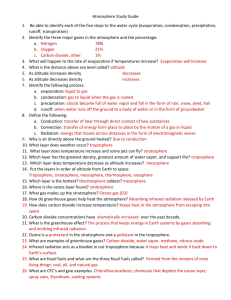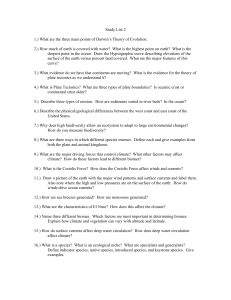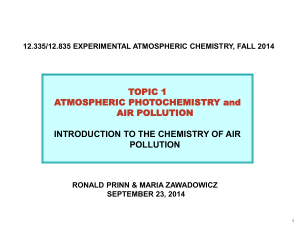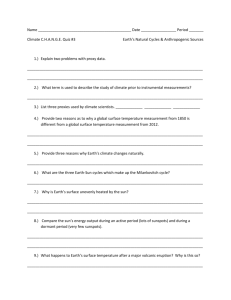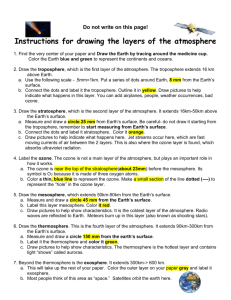Introduction to Atmosphere – Ocean Interactions
advertisement
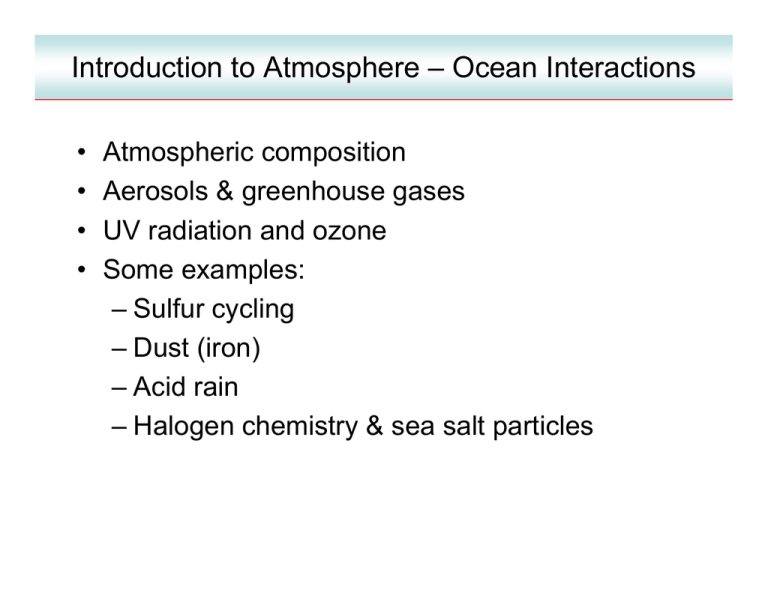
Introduction to Atmosphere – Ocean Interactions • • • • Atmospheric composition Aerosols & greenhouse gases UV radiation and ozone Some examples: – Sulfur cycling – Dust (iron) – Acid rain – Halogen chemistry & sea salt particles Vertical levels of the atmosphere Boundary Layer: ~ 1 km 100 0.001 0.002 0.005 0.01 0.02 Thermosphere 90 80 Mesopause 70 0.1 0.2 Mesosphere 60 0.5 1 50 Stratopause 2 40 5 Stratosphere 10 20 160 30 20 Tropopause 10 Troposphere 500 1000 Height (km) Pressure (mb) 0.05 50 100 200 Troposphere: region of strong vertical mixing 180 200 220 240 260 280 300 Stratosphere: region of weak vertical mixing Considerable differences in size, chemical nature, sources of the aerosols and gases 0 o Temperature ( K) Idealized vertical temperature profile according to the U.S. Standard Atmosphere (1976). Also shown are the names commonly used for the various layers and pauses in the atmosphere. Figure by MIT OCW. Transport across tropopause via large scale ascent in the tropics / descent in the poles, cloud convection, or tropopause folding Atmosphere – Ocean Interactions in a Nutshell Temperature - greenhouse effects Ozone concentrations Radiation budget Climate relevant gases CO2, O2, DMS, … Cloud microphysics Chemical reaction rates Oxidizing capacity Hydrological cycle Aerosols & sea-salts Wet and dry deposition Iron, acid rain, NOx Ecology Sunlight is a powerful structuring agent Direct deposition Mixing and stratification Photochemical reactions Biological processes Components of atmosphere N2 O2 H20 Ar C02 H2 CH4 N20 CO SO2 H2S O3 ppmv 780840 209460 0 - 40000 9340 350 0.53 1.7 0.3 0.04 – 0.2 10-4 10-4 .1 • ~ 78% nitrogen, 21% oxygen • Water vapor is the most variable component • Trace components can have enormous impacts on the radiation budget and inputs to the ocean • Lifetimes (residence times) vary from 107 – 109 years for N2 to days for ozone at high altitudes • Sources and sinks vary spatially and temporally Aerosols • Aerosol = suspension of particles in a gas • Liquid = cloud or mist • Solid = dust or smoke • The direct effect relates to the changes in net radiative fluxes in the atmosphere caused by the modulation of atmospheric scattering and absorption properties due to changes in aerosol concentration and optical properties • The indirect effect relates to the changes in net radiative transfer in the atmosphere caused by the modulation of cloud properties due to changes in the concentration of cloud condensation nuclei, CCN 4 types of aerosol reactions 1) Homogeneous, homomolecular = the condensation of a single gaseous component to form a new suspended particle (H20 molecules forming droplets) 2) Homogeneous, heteromolecular = reaction of 2 or more gases to form a new particle NH3(g) + HNO3(g) ⇒ NH4NO3(s) 3) Heterogeneous, heteromolecular = reaction of gases on a pre-existing particle NaCl(s) + HNO3(g) ⇒ HCl(g) + NaNO3(s) 4) Chemical reactions within the aerosols themselves to form particles of changed composition (oxidation of SO2 to sulfate ions in clouds) Absorption and scattering • Different gases & aerosols absorb at different λs: Direct absorption of UV by ozone (< 290 nm) • Scattering is a function of particle size relative to the λ of radiation: Rayleigh scattering: particles are generally small compared to the λs of light (gases) Mie scattering: particles are generally equal to or greater than the λs of light (aerosols & droplets) CCNs are ~0.1 μm containing 108 H20 molecules per drop Earth’s energy budget Figure by MIT OCW. Greenhouse gas warming λελ Intermediate Black Body Curves o o 6000 K 0.1 0.15 0.2 100 Absorption (%) 60 45 20 0 85 0.5 1 1.5 2 3 5 10 15 20 30 50 100 Ground Level 85 100 0.3 255 K CO O2 O2 O2 O 2 O2 O2 O H2O O2O2 2 H2O CO 2 H2O H O 2 CO 2 2 CO O2 O3 2 H O N O 2 2 H O 2 CH4 H O 2 N O O3 H O 2 2 CO CO2 N2O 2 CH • Absorb incoming photons and dissipate energy as heat • Greenhouse gases have overlapping infrared bands 4 11 km 60 45 Species removed % trapped radiation remaining CH4 None 100 N2O O3 97 CO2 88 Clouds 86 H2O 64 H2O, CO2, O3 50 H2O,O3,clouds 36 All 0 20 0 100 50 Absorption (%) 0 50 0 O2 and O3 50 0 CO2 50 0 H2O 50 0 0.1 0.15 0.2 0.3 0.5 1 1.5 2 3 5 10 15 20 30 50 100 Wavelength (µ) Figure by MIT OCW. Peixoto and Oort, 1992 Radiation at the ocean surface From Palmer Station, 2000 • • • • • UV-C = λs < 280 nm UV-B = λs 280 – 320 nm UV-A = λs 320 – 400 nm Visible = λs 400 – 700 nm IR = λs 700 nm – 1 mm The importance of UV radiation in the ocean • Overall a very small % of total solar flux but: – Affects biology – protein & nucleic acid damage, inhibits photosynthesis, bacterial production, photoenzymatic repair, etc. – Causes photochemical reactions • Inorganic – Nitrate/nitrite photolysis, Fe(III) reduction to Fe(II) • Organic – DOM breakdown & alteration Flux regulated by OZONE concentrations Stratosphere ozone chemistry • Stratosphere is dominated by oxygen atoms and ozone related reactions O2 + hν ( λ < 240 nm) ⇒ O(1D) + O(1D) O(1D) + O2 + M ⇒ O3 + M O3 + hν ( λ < 240 nm) ⇒ O(1D) + O2 O(1D) + O3 ⇒ 2O2 • UV light converted into heat • Ozone can be destroyed by a number of free radical catalysts: OH, NO, Cl, and Br • OH and NO are predominately natural while Cl and Br have anthropogenic origins from CFCs Antarctic ozone hole • Very low temps ( < 80 C) lead to formation of polar stratospheric clouds • A vortex forms as air cools and descends in winter • Strong westerly circulation isolates the region from lower latitudes Slow radiatively driven circulation Strong westerly wind in mid-low Stratosphere Cold core of Antarctic vortex Mixing a u se pop o r T 9 km ANTARCTIC CONTINENT The winter vortex over Antarctica. The cold core is almost isolated from the rest of the atmosphere, and acts as a reaction vessel in which the constituents may become chemically 'preconditioned' during the long polar night. Figure by MIT OCW. Antarctic ozone hole ABUNDANCE Inactive Chlorine Surface reaction Active Chlorine Gas-phase Reaction Inactive Chlorine ClONO2 ClONO2 (Cl2+ClO+(ClO)2) HCl Autumn TEMPERATURE • PSCs provide surfaces for chemical reactions • Highly deficient in oxides of nitrogen • Very dry → condensation of water • Catalytic destruction of ozone Cl2 + hν ⇒ Cl + Cl Cl + O3 ⇒ ClO + O2 ClO + O ⇒ Cl + O2 HCl Early Winter TIME Late Spring Denitrification and Dehydration Surface Processing Cl-catalysed O3 Destruction Inactive Chlorine Recovery Formation, Maximum Intensity cooling, descent Breakup Polar Vertex Evolution TIME Photochemistry and dynamics in the polar stratosphere. Figure by MIT OCW. Antarctic stratospheric ozone hole 2005 Figure courtesy NASA GSFC 1 Dobson unit = column ozone compressed to 10 um thick at STP Chemistry in the troposphere • Troposphere oxidation reactions are initiated by the highly reactive hydroxyl radical (OH) during the day O3 + hν ⇒ O2 + O(1D) an electronically excited state of the oxygen atom, O(1D) can then react with methane or water O(1D) + H2O ⇒ OH + OH O(1D) + CH4 ⇒ OH + CH3 • And nitrate radicals at night (nitrate is rapidly photolyzed) NO2 + O3 ⇒ NO3 + O2 • Govern fates of almost all trace gases in the troposphere Radiation Forcing The Global Mean Radiative Forcing of the Climate System for the year 2000, relative to 1750 Radiative Forcing (Watts per square metre) Cooling Warming 3 2 1 Halocarbons N2O CH4 CO2 Aerosols Tropospheric Ozone Black carbon from fossil fuel burning Mineral Dust Aviation-induced Contrails Cirrus 0 Stratospheric Ozone 1 2 Solar Organic Carbon Biomass Sulphate from Burning Fossil Fuel Burning Land-use (Albedo) only Aerosol Indirect Effect High Medium Medium Low Very Low Very Low Very Very Low Low Very Low Very Very Very Low Low Low Level of Scientific Understanding Figure by MIT OCW. • Our estimates are ‘best’ for the greenhouse gases and decrease in certainty for ozone processes and mineral and sulfate aerosols Now some examples of compounds that are of great interest in the ocean…. Biogenic sulfur cycle A negative climate feedback loop to stabilize temperature? # concentration of cloud droplets Cloud albedo Change in cloud optical thickness Cloud condensation nuclei (CCN) Cloud nucleation Sulfate Aerosols SO42- Atmospheric acidity & sulfur transport to continents Loss of solar radiation Oxidation Surface temp. of Earth DMSg Solar irradiance at ocean sfc Sea to air transport DMSaq Marine ecology and phytoplankton abundance, speciation, and synthesis rates of precursor, DMSP CLAW hypothesis after Charlson et al., 1987 Sulfur flux • DMS contributes > 90% of the oceanic sulfur flux and > 50% of the global biogenic flux • Estimated anthropogenic sources of sulfur are approximately three times larger than biogenic sources BUT the lifetimes are much shorter Upper Troposphere: Less than 20% of the sulfate is from anthropogenic sources Derived mostly from DMS Deep convective events Sulfur SO Dioxide2 Volcano Oil refining Coal and Oil Combustion Sea-spray Sulfate Aerosols SO42- Decay of vegetation Phytoplankton DMS DMS impacts atmospheric chemistry Carbonyl sulfide Hydrogen sulfide COS H2S OH OH OH, hν Carbon disulfide CS2 Wet or dry deposition OH Sulfuric acid OH SO2 NO3 night DMS OH or IO (DMSO) MSA or DMSO H2SO4 H2O2 OH day Wet or dry deposition Methanesulfonate Dimethylsulfoxide • Acid rain - in the North Sea region DMS can account for up to 25% of the tropospheric H2SO4 over Europe • Is thought to be the source of the stratospheric COS layer and background atm. levels of MSA, SO2, and nssSO42- Iron Cycling – Mineral aerosols • In the equatorial Pacific, the subarctic Pacific, and the Southern Ocean nitrate and phosphate concentrations are high year round and standing stocks of phytoplankton are always low = High Nitrate Low Chlorophyll (HNLC) regions • Iron limitation?? (1988, Martin and Fitzwater) • Fe(III) versus Fe(II) Source Flux Fluvial particulate total iron 625 to 962 1.5 Fluvial dissolved iron 34 to 211 Glacial sediments Atmospheric 16 Coastal erosion 8 Hydrothermal 14 Authigenic 5 Figure by MIT OCW. Jickells et al., 2005 Input of new iron to the surface waters is dominated by the atmospheric deposition of soluble iron in mineral aerosols (wet & dry deposition) Iron in the ocean Image removed due to copyright restrictions. • Sub-nanomolar concentrations in surface waters • Fe is extremely insoluble in oxygenated seawater, so the bio availability of Fe is controlled by presence of organic ligands that enhance Fe solubility Dust variability Image removed due to copyright restrictions. • Dust (iron) input to the ocean is highly variable: • • • • Spatially Seasonally (rainfall & transport patterns) & glacial-interglacial Episodic (wind speed) Solubility Dust transport examples SeaWiFS image from Feb 28, 2000 Image Courtesy NASA GSFC Rainfall sample from Sargasso Sea, July 2004 Nitrogen deposition • Nitrous oxide from the ocean contributes ~4 Tg yr-1 to the atmosphere (upwelling and deep convective areas) O(1D) + N2O ⇒ NO + NO • Anthropogenic sources of NOx (NOx = NO + NO2) are fossil fuels, biomass burning, and fertilizer • NOx chemistry in stratosphere: NO + O3 ⇒ NO2 + O2 OH + NO2 + M ⇒ HNO3 + M (M = species which dissipates energy) • HNO3 nitric acid is highly soluble in droplets = wet depositions • Photolysis of NO2 is the only known way of producing ozone in the troposphere Acid Rain GLOBAL PATTERN OF ACIDITY OF PRECIPITATION 4.6 5.0 4.4-5.6 4.5 5.5 5.0 6.0 4.5 4.0 4.0-5.0 5.0 4.5 4.5-5.0 6.0 5.0 5.9 5.0 6.3 5.5 5.5 5.2 4.7 4.7 5.1 4.7 4.1 3.8-5.4 Areas where effects have been reported Isolated measurements in remote areas 6.3 Estimated Distribution of pH Figure by MIT OCW. • Natural precipitation is slightly acidic (~ 5.6) • HNO3 & H2SO4 decrease pH & deliver N and S to the surface ocean Halogen chemistry • Organic biogenic oceanic sources: methyl halides CH3Cl, CH3Br, CH3I • CH3Cl, CH3Br have lifetimes > 1 year wrt OH so they can reach the stratosphere and function as catalytic species in O3 chemistry • Inorganic sources: sea salt which is ‘activated’ NaCls + ClONO2g ⇒ Cl2g + NaNO3s Cl2 is readily photolyzed in the troposphere • Sea-salt particles are an important removal pathway (reaction surface) of nitrogen oxides in the marine troposphere: HNO3(g) + NaCl(s,aq) --> NaNO3(s,aq) + HCl(g) This affects the NOx partitioning and the ozone chemistry Summary • Atmospheric gases and aerosols impact the global radiation and heat budget • Trace constituents dominate these effects • The reaction pathways and feedback mechanisms are often complex, interrelated, and cyclical making climate change estimates difficult • Many biogeochemical cycles deliver key substances to the ocean (iron, nitrogen, sulfur) and vice versa
